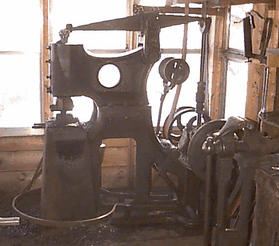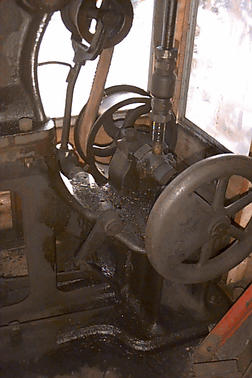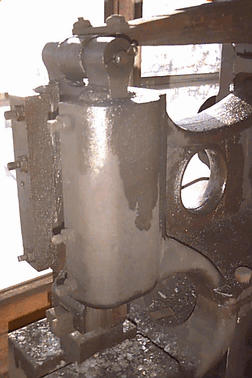


It now belongs to Tim Bollivar in Hebb's Cross, NS and these pictures were taken in his shop. He runs the belt directly off the end of a car transmission powered by the motor, both partly visible in one of the photos.

No clutch, just a tension pulley on the flat belt. The leaf spring is
held between two cheek pieces that pivot a bit on both the spring and
the hammer body. This should allow the end of the spring over the ram
to move in a straight line rather than an arc but it also tends to
push the ram forward and back, causing wear or, after the wear occurs,
slop.
The ram is a ca. 100 pound flat slab except for the eyes at the top
and the broader area where the die attaches. The back side of the ram
guides against the upper main body itself and against a pair of heavy,
ca. 1/2" thick shims in front. The shims are adjusted (rather
inadequately) with the screws that can be seen on the front of the
hammer.

Note the opening fore & aft through the hammer body where the two
pieces bolt together. This makes it possible to get a longer
workpiece into the dies in that direction. It also makes it possible
to drive the die wedges out, which would be very hard if you couldn't
poke a long rod through from near the con rod.

Die opening is adjusted with a heavy square-thread turnbuckle with locknuts.
Two of the adjuster screws are broken off and need to be drilled out.
The guides are worn somewhat unevenly so that it's impossible to
adjust it so that it neither woggles nor sticks.

There's no name, no date or other markings on the hammer. No one I talked to had ever had seen one like it until I contacted Douglas Freund, author of Pounding Out the Profits. He reports:
It is undeniably a "Palmer Power Spring Hammer" This hammer was built by S. C. Forsaith in Manchester NH. Joseph Palmer was granted his patent in 1872. Several pages of Pounding Out the Profits are devoted to this machine; and - given its sculptural attributes - I used it on the title page of the book.Thanks, Doug. Thirty-five year old mystery cleared up.